Growing Bromeliads Together Part 2
Author: Celeste BoothNo Comments
Care and Culture, Growing Indoors
Because we believe the best way to learn about growing bromeliads is through experience, last month we began a series about growing bromeliads by a guest author. Sarah is a first time bromeliad owner with limited previous houseplant experience. She is raising two different bromeliad plants in her home and sharing her adventure and acquired knowledge with us. If you missed the first post, you can read it here.
Ordering
As planned, I ordered my bromeliads from Tropiflora after the holidays. It took them about four days to get to my home and I used the standard shipping option. There are faster shipping options available, but I didn’t want to pay the extra money. I live in a rather moderate climate, so I didn’t have to worry about the plants being damaged in shipping. Tropiflora recommends waiting for the weather to warm up a bit before shipping your plants if you live in a cold climate. You can go ahead and pick out your plants, but hold the shipping until spring. Bromeliads are also really easy to find in any store that has a garden center. However, your choice of varieties and instructions for care may be more limited. If you want to get started growing a bromeliad during the winter, buying it in a store is probably your best option.
My plants showed up on January 11th. The two plants came in a surprisingly small box. They were carefully packed in newsprint and arrived in great shape.
Mounting the Air Plant
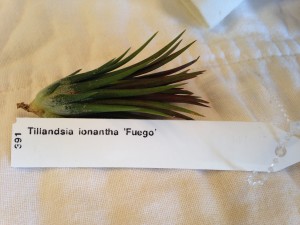
The Tillandsia ionantha ‘Fuego’ is just a few inches long.
I mounted the Tillandsia ionantha ‘Fuego’ and hung it in my window. I was nervous about what it would be like to mount a plant because it looked complicated. I was afraid I would easily wreck the plant. However, the mounting process
was really simple. I placed a small dab of hot glue on the end of some heavy twine. I waited a few seconds for the glue to cool just a bit and then I pushed the flattest side of the base of the air plant into the glue. There is a small space at the bottom of the plant that is a little more brown and dry looking than the green leaves. This is the area I glued, being careful not to let the hot glue touch the leaves. I pressed a push pin into the top of the window frame to hang the twine. Once the air plant was in the window the small, skinny leaves opened up some and the center leaves became a brighter red.
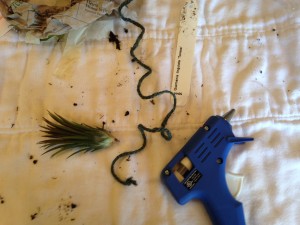
I just used a dab of hot glue to attach the Tillandsia to a piece of twine
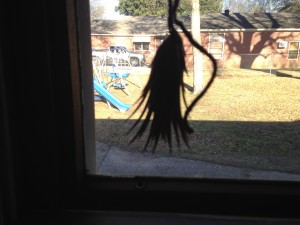
The final product hung in the kitchen window.
Watering the Tillandsia
About every third day the Tillandsia needs water. You can see the silvery scales in the picture towards the base of the plant. These scales are called trichomes and they are what take in water instead of roots. Those little scales are why you can hang a Tillandsia in the air or mount it without any dirt.
Each time I water the plant I take down the twine and dunk it in a small container filled with distilled water. Then I hang the plant over the container for a few minutes while the excess drips off. I use distilled water because it doesn’t have any of the minerals that tap water has. Without those minerals there won’t be any ugly or harmful build up on the leaves. I let the plant drip over the container for a few minutes before I hang it back up so the plant doesn’t drip water all over my window. The plant should have enough air circulation that is doesn’t stay wet for more than four hours. My air plant dries out really quickly.
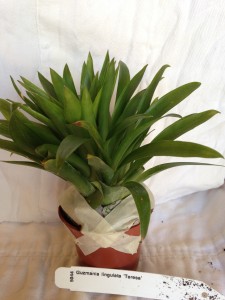
The Guzmania arrived in a small plastic pot with some moist newsprint taped around the top.
The Guzmania
The Guzmania lingulata ‘Teresa’ came in a small plastic pot with a little potting material around it. There was moist newsprint taped around it to keep it damp.
The pot it came in was just small enough to fit inside a cute little mug I got in Brazil. I thought a South American mug would be appropriate for a South American plant! I put a few decorative glass rocks in the bottom to prop up the pot. Those rocks will also prevent the pot from sitting in any excess water that might run out into the mug. I also used glass rocks around the top of the container to stabilize the plant and make it look nicer.
Watering the Guzmania
The mug doesn’t have any drainage holes, so I slip the smaller pot out
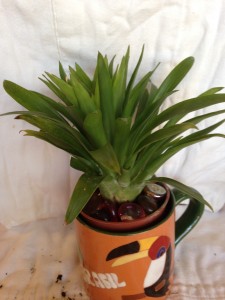
The pot fit into a small mug with a few rocks on the bottom to prop it up.
to water it. I have poured distilled water over the center cup made by the leaves and into leaf axils letting the water run down through the potting medium. I let any extra water set in the center cup. I only need to water this plant once a week. This may be even too often. So far I have not needed to empty any stagnate water out of the central cup. The central cup is small and the water seems to be evaporating quickly.
Root Rot?
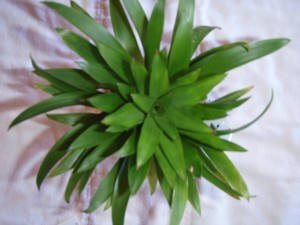
The small central tank formed by the rosette doesn’t hold water for very long.
I think the potting medium might be staying too wet inside the mug. A few of the lower leaves are starting to turn yellow and the base of the plant at the center feels a little mushy. Guzmanias, like a lot of bromeliads, are prone to root rot and mushy yellow leaves are signs that the plant is suffering. I need to cut back on watering and I may need to move the plant from the little mug to something that will allow the potting medium to dry out faster. Hopefully it is not too late to save the plant.
My Three Pieces of Advice
- Don’t be afraid of mounting an air plant. It is very easy.
- Don’t overwater. Water less than you think you need to, not more.
- Ordering plants is easy, but make sure the weather is right so your plants aren’t damaged by cold or frost.
Bromeliads Out and About
I’ve noticed that when I start a project I begin to see it everywhere I go. The Chick-Fil-A I stopped in the other day had cute little bromeliads in red tin pots with a pretty, flat, red flower. There was a plant on every table in the restaurant. Where have you noticed bromeliads? Have you started growing bromeliads? What challenges have you faced? How did you display them?
Sources
“How to Grow Air Plants” Better Homes and Gardens. <http://www.bhg.com/gardening/houseplants/care/grow-air-plants/>
“Air Plant Care Instructions.” Tillandsia International. <http://www.airplant.com/indcare.html>
“Care of Guzmania.” Garden Guides. <http://www.gardenguides.com/67743-care-guzmania.html>
“Getting to Know the Guzmania Bromeliad.” Bromeliads.info <https://www.bromeliads.info/guzmania-bromeliad/>
“Exploring the Tillandsia Bromeliad.” Bromeliads.info. <https://www.bromeliads.info/tillandsia-bromeliad/>

Resource Download
Hechtia Care Cheat Sheet
Learn how to care for your Hechtia bromeliad with this quick and easy informational guide.
Learn More
Ask an Expert
Questions about bromeliads?
Our experts love a challenge!
Photo of the Week
Submit your photo to be featured on the blog!
More Photo of the Week Winners
Submit Photo







